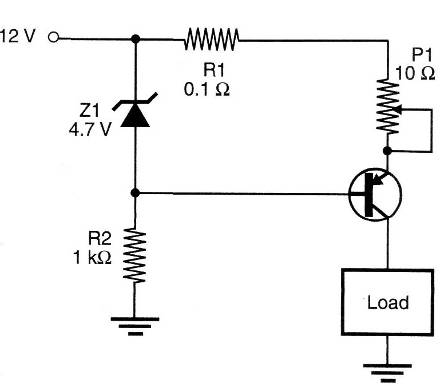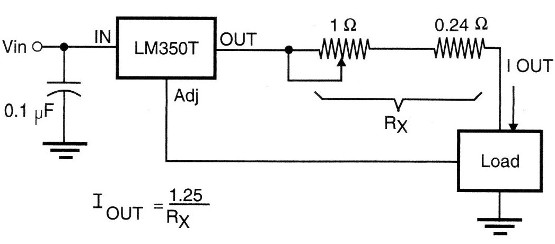Another case is found when shape memory alloys (SMAS) are powered, and the current across them must be kept to within a narrow band of values even when the control voltage changes.
Finally, we can consider cases in which incandescent lamps need to maintain constant brightness even when the input voltage changes, and heaters whose resistance.
Changes With temperature (resistance drops when the temperature falls) and thus require some kind of regulation in to be suitable for robotics, automation, or mechatronics applications.
The constant current source can be used to maintain a predetermined current value in a load even when the resistance of the load is altered or when the input voltage of the circuit is changed. The following blocks can be used for this task.(*)
Constant Current Source Using Transistor
An interesting block for robotics and mechatronics designers is the one shown in Figure 1.

This circuit maintains a constant current flow across a load. This can be important to keep the motor speed constant even when its load changes, or to keep the current across a heater constant when its temperature changes, thus altering its resistance.
The zener diode is a 400 mW or 1 W type, and Pl is used to adjust the current across the load. This circuit can be used to maintain constant currents up to 500 mA.
If larger currents are involved, a Darlington transistor can be used.
P1 must be a wire-wound potentiometer, and its dissipation rate is important if larger loads are controlled. The current adjustment can be made using a current meter in series with the load.
If higher voltages are used at the input, the 1 k resistor must be increased in value, and the zener must have larger dissipation power. If the load is a motor, it is convenient to add a decoupling capacitor in parallel. Electrolytic capacitors between 1 and 470 uF are recommended for this task.
Constant Current Source Using the LM350T (3 A)
A current up to 3 A can be kept constant across a load using the block shown in Figure 2.

The LM35oT is a three-lead T0220 packaged IC consisting of a variable voltage regulator with output currents up to 3 A. Using the configuration shown in the figure, the circuit operates as a current regulator, keeping the current constant across a load.
The potentiometer is used to adjust the current across the load, and the resistor limits the highest value. The IC must be mounted on a heatsink. Input voltage is typically between 12 and 24 V.



